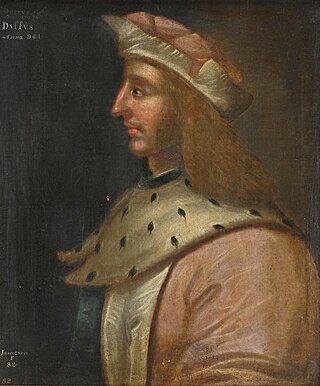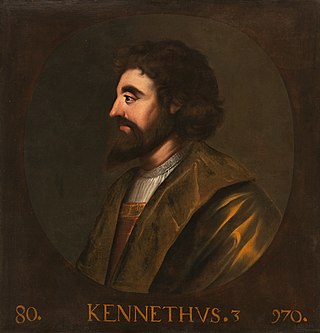Related Research Articles

Dub mac Maíl Coluim, Dub mac Maíl Coluim is the Mediaeval Gaelic form. The modern form, Dubh, has the sense of "dark" or "black", especially in reference to hair colour. Sometimes anglicised as Duff MacMalcolm, this form was used in older histories, but is not commonly used today called Dén, "the Vehement" Duan Albanach, and "the Black" a direct translation of his name to modern English is Black Malcolmson was king of Alba. He was son of Malcolm I and succeeded to the throne when Indulf was killed in 962.

Cináed mac Maíl Coluim was King of Alba (Scotland) from 971 to 995. The son of Malcolm I, he succeeded King Cuilén on the latter's death at the hands of Rhydderch ap Dyfnwal in 971.
Cináed mac Duib, anglicised as Kenneth III, and nicknamed An Donn, was King of Alba (Scotland) from 997 to 1005. He was the son of Dub. Many of the Scots sources refer to him as Giric son of Kenneth son of Dub, which is taken to be an error. An alternate explanation is that Kenneth had a son, Giric, who ruled jointly with his father.
In early medieval Scotland, a mormaer was the Gaelic name for a regional or provincial ruler, theoretically second only to the King of Scots, and the senior of a Toísech (chieftain). Mormaers were equivalent to English earls or Continental counts, and the term is often translated into English as 'earl'.
The Earl of Fife or Mormaer of Fife was the ruler of the province of Fife in medieval Scotland, which encompassed the modern counties of Fife and Kinross. Due to their royal ancestry, the earls of Fife were the highest ranking nobles in the realm, and had the right to crown the king of Scots.

Donnchadh was a Gall-Gaidhil prince and Scottish magnate in what is now south-western Scotland, whose career stretched from the last quarter of the 12th century until his death in 1250. His father, Gille-Brighde of Galloway, and his uncle, Uhtred of Galloway, were the two rival sons of Fergus, Prince or Lord of Galloway. As a result of Gille-Brighde's conflict with Uhtred and the Scottish monarch William the Lion, Donnchadh became a hostage of King Henry II of England. He probably remained in England for almost a decade before returning north on the death of his father. Although denied succession to all the lands of Galloway, he was granted lordship over Carrick in the north.
Níall of Carrick was the second man to bear the title Mormaer, or Earl, of Carrick. He was successor of mormaer Donnchadh of Carrick. Originally he was believed to be the son of Donnchadh, however, it is now believed that he was more likely his grandson, the son of Donnchadh's oldest son and heir Cailean mac Donnchadh. Cailean, also known as Colin and Nicholaus of Carrick, predeceased his father and therefore upon Donnchadh's death in 1250, the title of Mormaer came to Niall. It has been suggested that Cailean's wife, Niall's mother, was a daughter of Niall Ruadh, briefly king of Tir Eoghain. Niall's grandfather Donnchadh held lands in Ireland, such a marriage of his son would have reinforced Donnchadh's Irish alliances and would account for the use of the name Niall. It would also explain the strong alliance with the Ó Neill held by Niall's grandsons. As the son of Cailean, Niall had one sister, Afraig, who married Gilleasbaig of Menstrie, a baron of Clackmannanshire who was the first attested man to bear the surname "Campbell".
Causantín or Constantine of Fife is the first man known for certain to have been Mormaer of Fife.
Donnchad II, anglicized as Duncan II or Dunecan II, succeeded his father Duncan I as Earl of Fife in childhood. As a child of the previous mormaer, he was entitled to succeed his father through primogeniture, but not to lead his kin-group, Clann MacDuib. That probably fell to his cousin, Aed mac Gille Míchéil. Like previous mormaers of Fife, Duncan II was appointed Justiciar of Scotia. Donnchad's minority also meant that Ferchar, Mormaer of Strathearn, took supreme place as head of the Gaelic nobility and guide for the boy-king Malcolm IV.

Mormaer Máel Coluim of Fife (1204–1228), or Maol Choluim anglicised as Malcolm, was one of the mormaers of Fife.

Máel Coluim II, was a 13th-century Mormaer of Fife who ruled the mormaerdom or earldom of Fife between 1228 and 1266. He was the nephew of Máel Coluim I, the previous mormaer, and the son of Máel Coluim I's brother Donnchadh, son of Donnchadh II.

Donnchadh IV, Earl of Fife [Duncan IV] (1289–1353) was a Scottish nobleman who was Guardian of Scotland and the last native Scottish Mormaer of Fife from 1289 until his death.

Domhnall I, Earl of Mar, also known by the name Domhnall mac Uilleim, was the seventh known mormaer of Mar in medieval Scotland, ruling from the death of his father, Uilleam of Mar, in 1276 until his own death sometime between 1297 and 1302. If Gille Críst is excluded, Domhnall I is considered the sixth mormaer or Earl of Mar.
Fergus of Buchan was the last native Gaelic Mormaer of Buchan, and only the third to be known by name as Mormaer. Fergus appears to have had strong connections in Fife, and it is possible that his father Colbán was a Fifer. A charter issued by Fergus appears to have survived. The charter is a feudal charter granting lands to a subordinate. The charter had a few witnesses with French names, presumably a phenomenon related to his Comyn connections. Fergus had no male heirs, and married his only daughter Marjory to William Comyn, bringing Gaelic control of the Mormaership to an end. On Fergus' death, Buchan became the first native mormaerdom to pass into the hands of a foreign family
Ethelred was the son of King Malcolm III of Scotland and his wife Margaret of Wessex, the third oldest of the latter and the probable sixth oldest of the former. He took his name, almost certainly, from Margaret's great-grandfather Æthelred the Unready. He became the lay abbot of Dunkeld.
Scottish Society in the High Middle Ages pertains to Scottish society roughly between 900 and 1286, a period roughly corresponding to the general historical era known as the High Middle Ages.
The Meic Uilleim (MacWilliams) were the Gaelic descendants of William fitz Duncan, grandson of Máel Coluim mac Donnchada, king of Scots. They were excluded from the succession by the descendants of Máel Coluim's son David I during the 12th century and raised a number of rebellions to vindicate their claims to the Mormaerdom of Moray and perhaps to the rule of Scotland.

Alexander Comyn, 2nd Earl of Buchan was a Scoto-Norman magnate who was one of the most important figures in the 13th century Kingdom of Scotland. He was the son of William Comyn, Lord of Badenoch, and Marjory, Countess of Buchan, the heiress of the last native Scottish Mormaer of Buchan, Fergus. He was the chief counsellor of Alexander III, King of Alba (Scotland) for the entire period of the king's majority and as Scotland's leading magnate, played a key role in safeguarding the independence of the Scottish monarchy. During his long career, Alexander Comyn was Justiciar of Scotia (1258–1289), Constable of Scotland (1275–1289), Sheriff of Wigtown (1263–1266), Sheriff of Dingwall (1264–1266), Baillie of Inverie and finally, Guardian of Scotland (1286–1289) during the first interregnum following the death of Alexander III. In 1284 he joined with other Scottish noblemen who acknowledged Margaret of Norway as the heiress to King Alexander. He died sometime after 10 July 1289.
Thane was the title given to a local royal official in medieval eastern Scotland, equivalent in rank to the son of an earl, who was at the head of an administrative and socio-economic unit known as a thanedom or thanage.
Adam of Kilconquhar was a Scottish noble from the 13th century. Of Fife origin, he is notable for becoming the husband of the Countess of Carrick and participating in the Ninth Crusade under the command of Lord Edward, Duke of Gascony.
References
- ↑ Donaldson, Gordon, Scottish Historical Documents, Edinburgh, 1970, ISBN 0-7011-1604-8 p. 37, in the 1284 document acknowledging the Maid of Norway as heir, he is described as "Duncan, Earl of Fife"
- ↑ Foedera, p. 228
- ↑ Richardson, Douglas, Plantagenet Ancestry, Baltimore, 2004, ISBN 0-8063-1750-7 p. 505